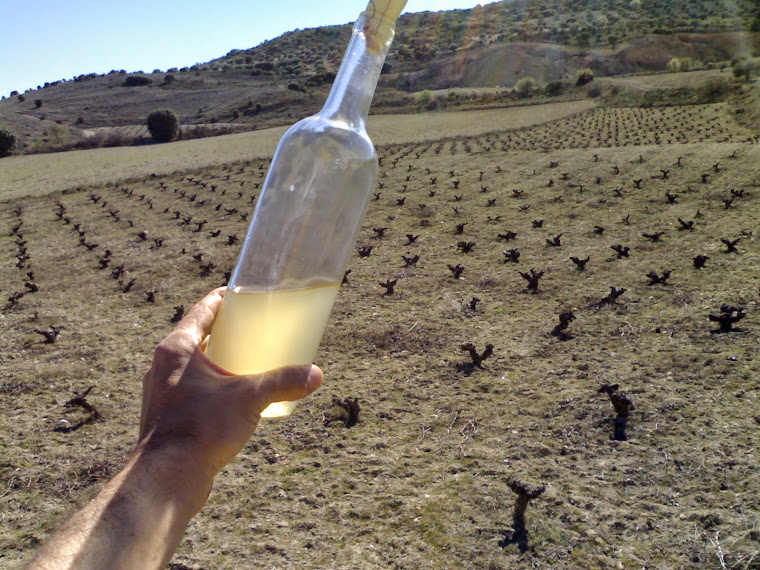This seems a good moment to post a progress report on all my wines and experiments from 2012, because it’s the deepest, darkest coldest point of the year here in central Spain, so the wines have already progressed and developed and evolved a bit, and they’re already showing an indication of how they’re going to proceed.
I’m writing this while touching wood because it would be just typical if I were to say that they’re all coming along fine, and then two days later something awful would happen!
But the fact is, that all the wines are doing just fine (more or less!):
1.Airén. This is a wine I make every year, and can be drunk very young. In fact, I started bottling it in December and have been distributing it locally here in Madrid already. At this stage in its life cycle it’s very fruity both in the nose and in the mouth. It’s nothing like any other 100% Airén you may find on sale (generally wishy-washy, insipid, and inoffensive), as this wine actually has a good body, and intense aromas and tastes. As time goes by, it loses it fruity, flowery characteristics, and becomes quite dry and sherry-like. By June/July it is in fact totally sherry-like. Some years, it’s sparkling for the first few months, but this year it’s not.
2.Tempranillo. This is another wine that I make every year. This year, due to the drought and to the rabbits, I only harvested enough grapes to make one (1) barrel of Crianza! At the time of writing (Jan 13) it’s still in the stainless steel fermentation tank, and I racked it once, a few days after pressing, back in October. I’ll move it into an old barrel as soon as I have time, maybe in February, where it will sit for about a year or so, depending on how old the barrel was, and on tastings,
3.Malvar No.1. I made one lot of Malvar (from 100-yr old vines from Villarejo) by straight carbonic maceration. Clusters destemmed and sealed in a stainless steel tank for 15 days. Then crushed and pressed, and left alone to finish fermentation. Tasting good, maybe to be released in March.
4.Malvar No.2. The second lot of Malvar (from the same vineyard) I made with about 30 days skin contact. This is the so-called “orange” wine. Tasting good. I don’t know whether to release or not, because I think it might even get better over time. Have to think. And taste.
5.Malvar. No.3. The third lot of Malvar (still from the same vineyard) I made in old clay amphoras (or ‘tinajas’ as they’re called in Spain) (or ‘qvevri’ as they’re called in Georgia). Back in September, I crushed the grapes and poured everything into the amphorae. I punched down the cap for a week or two, until it stopped rising, and haven’t touched them since then! I scoop out a sample every now and then from the top of the amphora, to check it. Beautiful! (touch wood). Tasting good. This lot I’m definitely going to let sit there for at least six months, maybe even longer, on all the skins and pips, which have already sunk to the bottom.
6.Malvar No.4. The same as the amphora above, but in an old open top oak barrel. I have no idea what to do with this lot! So I guess I’ll just leave it alone, keep tasting it, have tasters taste it, and decide some other time!
7.Garnacha No.1. This is a lot of Garnacha from the Sierra de Gredos (specifically from the village of Sotillo de la Adrada). I’m totally amazed by this wine, and I’m kicking myself for not taking proper notes, because I’d like to make more of it next year, but I fear I can’t remember exactly what/how/when I did what I did! This Garnacha is total drinkable now! I think it would be a loss if I were to try and age it or blend it or whatever. I need to have some more tasters taste it and get feedback from them, but my heart/intuition (and feedback received to date) tells me that this has to be a young wine and it has to be drunk now.
8.Garnachas Nos.2 and 3. These are other lots of Garnachas from Gredos, one from Sotillo de la Adrada, and one from Méntrida. These are all still evolving, and are not very nice to drink young at the moment, unlike Lot No.1. Again I need to have some tasters taste them, but I think these will be good for blending and/or aging. It’s early days though, and they’ll continue to evolve over spring.
9.Garnachas Nos.4 and 5. Same as above (Nos.2 & 3), but with a spontaneous ‘velo de flor’!
10.Rojilla experiment. I’ve only got 1 ‘arroba’ of this strange, uncommon, unknown grape variety. It’s in a glass demijohn and I haven’t tasted it since last October, so I’ve no idea how it’s turned out.
And that, I’m afraid to say, is that!
I was expecting to do a lot more in 2012, but the rabbits, the weather, and the Spanish bureaucrats prevented me from achieving my goals. But not to worry. This year I shall try again. Basically, I hope to find a bigger winery/shed/place in which to make more wines. That’s not much to ask for, is it?

